Project Planning and Budgeting: Cost and Quality Management
VerifiedAdded on 2020/02/24
|7
|1357
|164
Report
AI Summary
This report provides a comprehensive analysis of project planning and budgeting for the production of 10,000 rubber components. It details the project's deliverables, including a project plan and tender proposal, emphasizing the importance of cost and quality. The report explores cost management techniques, such as the PMBOK analysis, cost baselines, and various cost determiners. It also examines tools and techniques like cost variance, schedule variance, cost performance index, and schedule performance index. Furthermore, the report outlines a quality management plan (QMP) to ensure acceptable quality standards and define quality assurance activities. Finally, it addresses the constraints of the project, particularly the time factor and the accuracy of financial figures. The report incorporates relevant references to support its findings.
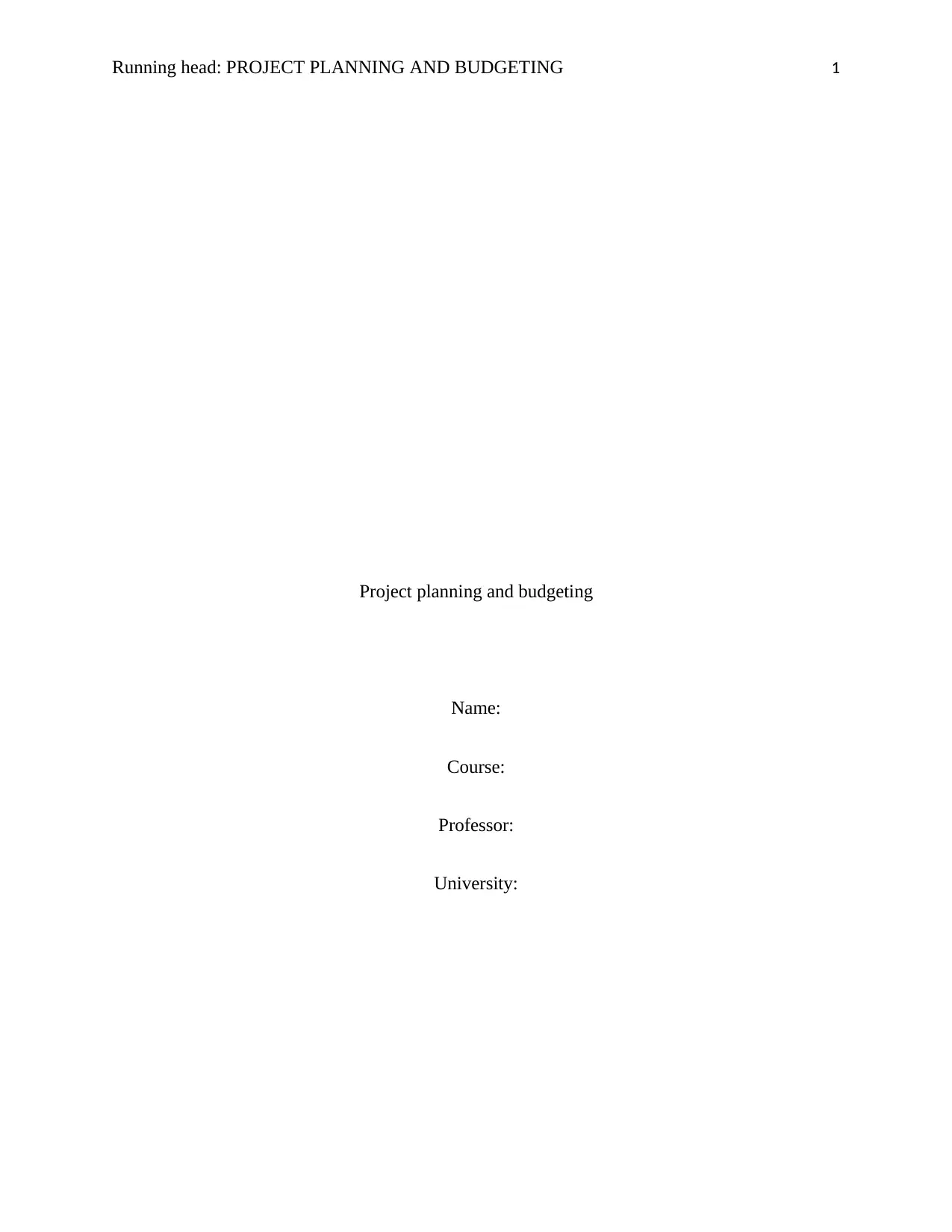
Running head: PROJECT PLANNING AND BUDGETING 1
Project planning and budgeting
Name:
Course:
Professor:
University:
Project planning and budgeting
Name:
Course:
Professor:
University:
Paraphrase This Document
Need a fresh take? Get an instant paraphrase of this document with our AI Paraphraser
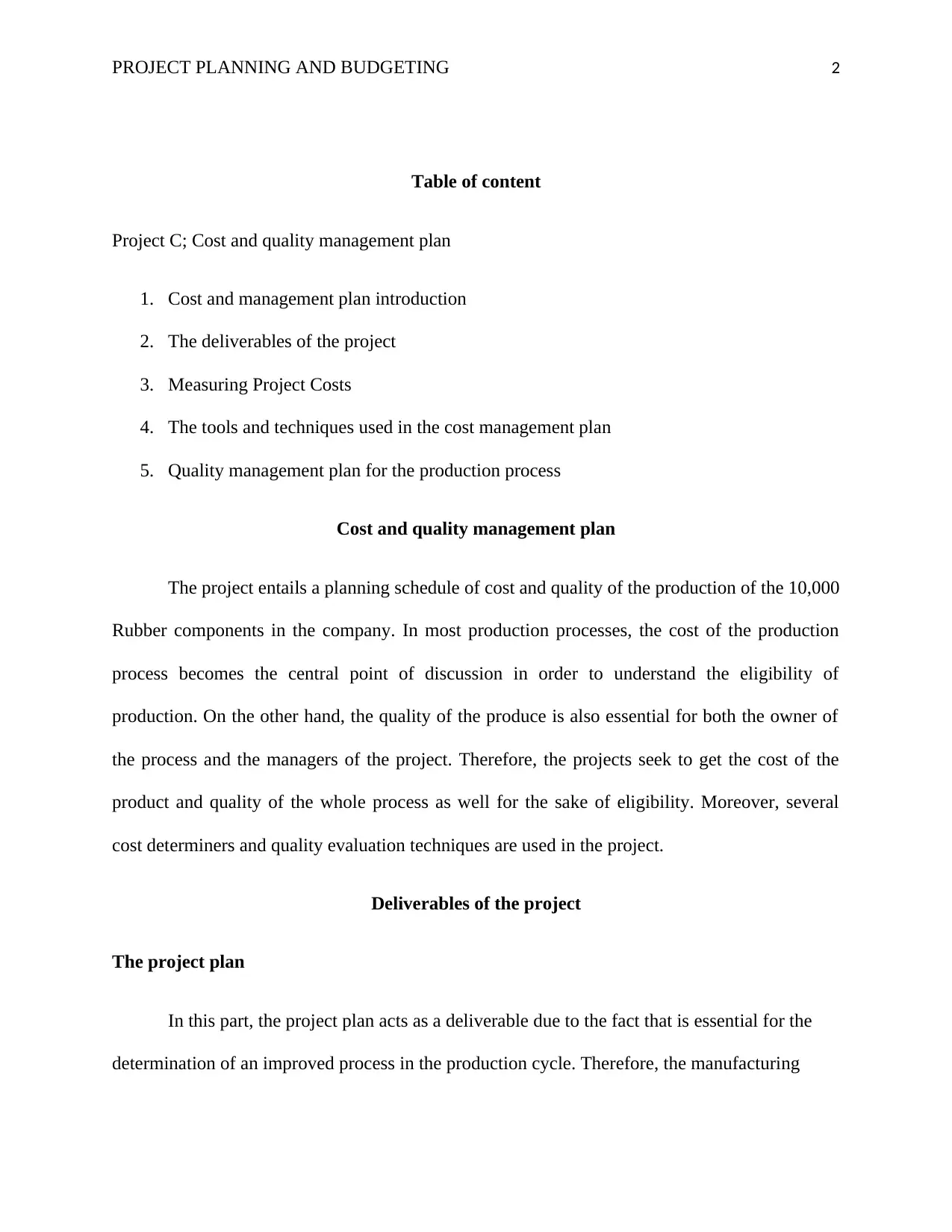
PROJECT PLANNING AND BUDGETING 2
Table of content
Project C; Cost and quality management plan
1. Cost and management plan introduction
2. The deliverables of the project
3. Measuring Project Costs
4. The tools and techniques used in the cost management plan
5. Quality management plan for the production process
Cost and quality management plan
The project entails a planning schedule of cost and quality of the production of the 10,000
Rubber components in the company. In most production processes, the cost of the production
process becomes the central point of discussion in order to understand the eligibility of
production. On the other hand, the quality of the produce is also essential for both the owner of
the process and the managers of the project. Therefore, the projects seek to get the cost of the
product and quality of the whole process as well for the sake of eligibility. Moreover, several
cost determiners and quality evaluation techniques are used in the project.
Deliverables of the project
The project plan
In this part, the project plan acts as a deliverable due to the fact that is essential for the
determination of an improved process in the production cycle. Therefore, the manufacturing
Table of content
Project C; Cost and quality management plan
1. Cost and management plan introduction
2. The deliverables of the project
3. Measuring Project Costs
4. The tools and techniques used in the cost management plan
5. Quality management plan for the production process
Cost and quality management plan
The project entails a planning schedule of cost and quality of the production of the 10,000
Rubber components in the company. In most production processes, the cost of the production
process becomes the central point of discussion in order to understand the eligibility of
production. On the other hand, the quality of the produce is also essential for both the owner of
the process and the managers of the project. Therefore, the projects seek to get the cost of the
product and quality of the whole process as well for the sake of eligibility. Moreover, several
cost determiners and quality evaluation techniques are used in the project.
Deliverables of the project
The project plan
In this part, the project plan acts as a deliverable due to the fact that is essential for the
determination of an improved process in the production cycle. Therefore, the manufacturing
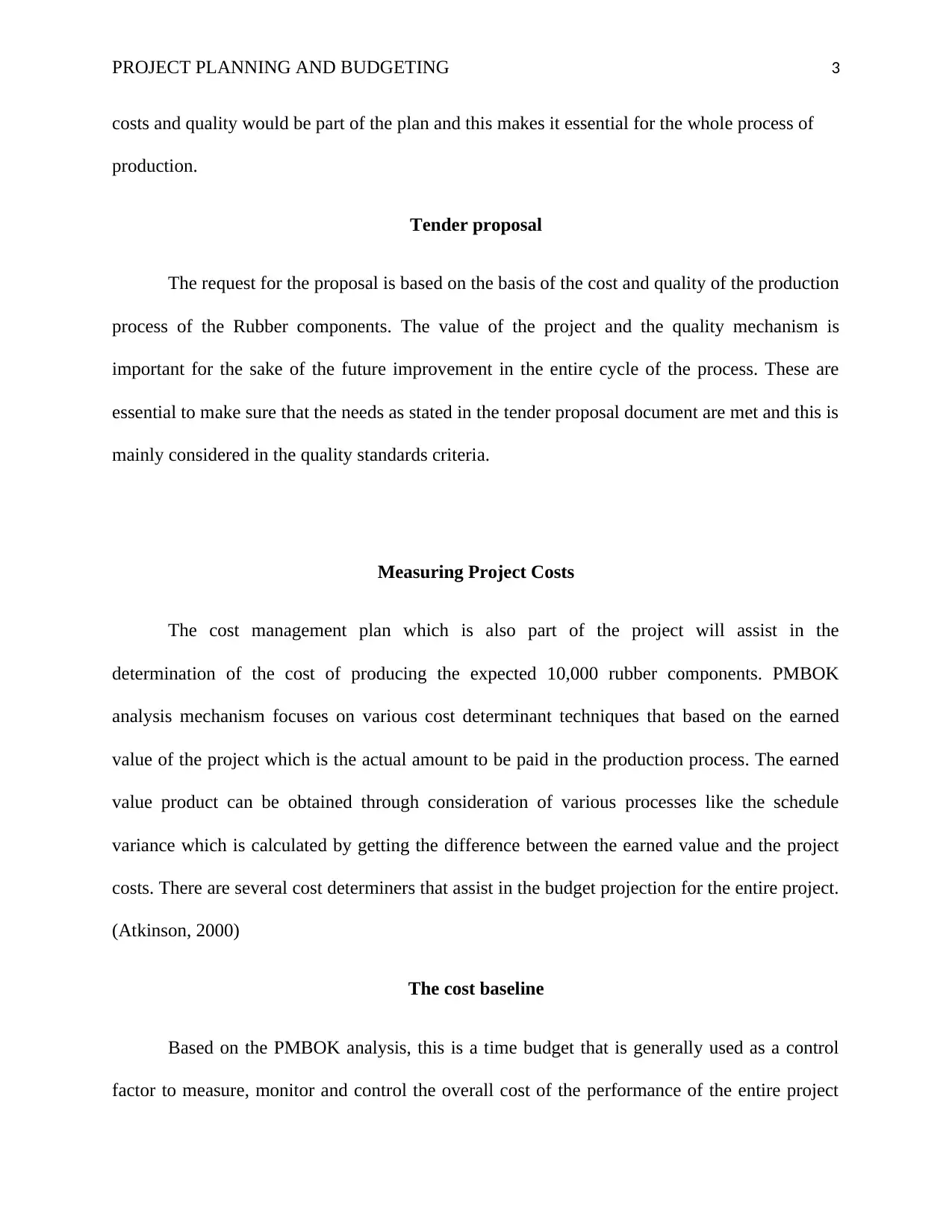
PROJECT PLANNING AND BUDGETING 3
costs and quality would be part of the plan and this makes it essential for the whole process of
production.
Tender proposal
The request for the proposal is based on the basis of the cost and quality of the production
process of the Rubber components. The value of the project and the quality mechanism is
important for the sake of the future improvement in the entire cycle of the process. These are
essential to make sure that the needs as stated in the tender proposal document are met and this is
mainly considered in the quality standards criteria.
Measuring Project Costs
The cost management plan which is also part of the project will assist in the
determination of the cost of producing the expected 10,000 rubber components. PMBOK
analysis mechanism focuses on various cost determinant techniques that based on the earned
value of the project which is the actual amount to be paid in the production process. The earned
value product can be obtained through consideration of various processes like the schedule
variance which is calculated by getting the difference between the earned value and the project
costs. There are several cost determiners that assist in the budget projection for the entire project.
(Atkinson, 2000)
The cost baseline
Based on the PMBOK analysis, this is a time budget that is generally used as a control
factor to measure, monitor and control the overall cost of the performance of the entire project
costs and quality would be part of the plan and this makes it essential for the whole process of
production.
Tender proposal
The request for the proposal is based on the basis of the cost and quality of the production
process of the Rubber components. The value of the project and the quality mechanism is
important for the sake of the future improvement in the entire cycle of the process. These are
essential to make sure that the needs as stated in the tender proposal document are met and this is
mainly considered in the quality standards criteria.
Measuring Project Costs
The cost management plan which is also part of the project will assist in the
determination of the cost of producing the expected 10,000 rubber components. PMBOK
analysis mechanism focuses on various cost determinant techniques that based on the earned
value of the project which is the actual amount to be paid in the production process. The earned
value product can be obtained through consideration of various processes like the schedule
variance which is calculated by getting the difference between the earned value and the project
costs. There are several cost determiners that assist in the budget projection for the entire project.
(Atkinson, 2000)
The cost baseline
Based on the PMBOK analysis, this is a time budget that is generally used as a control
factor to measure, monitor and control the overall cost of the performance of the entire project
⊘ This is a preview!⊘
Do you want full access?
Subscribe today to unlock all pages.

Trusted by 1+ million students worldwide
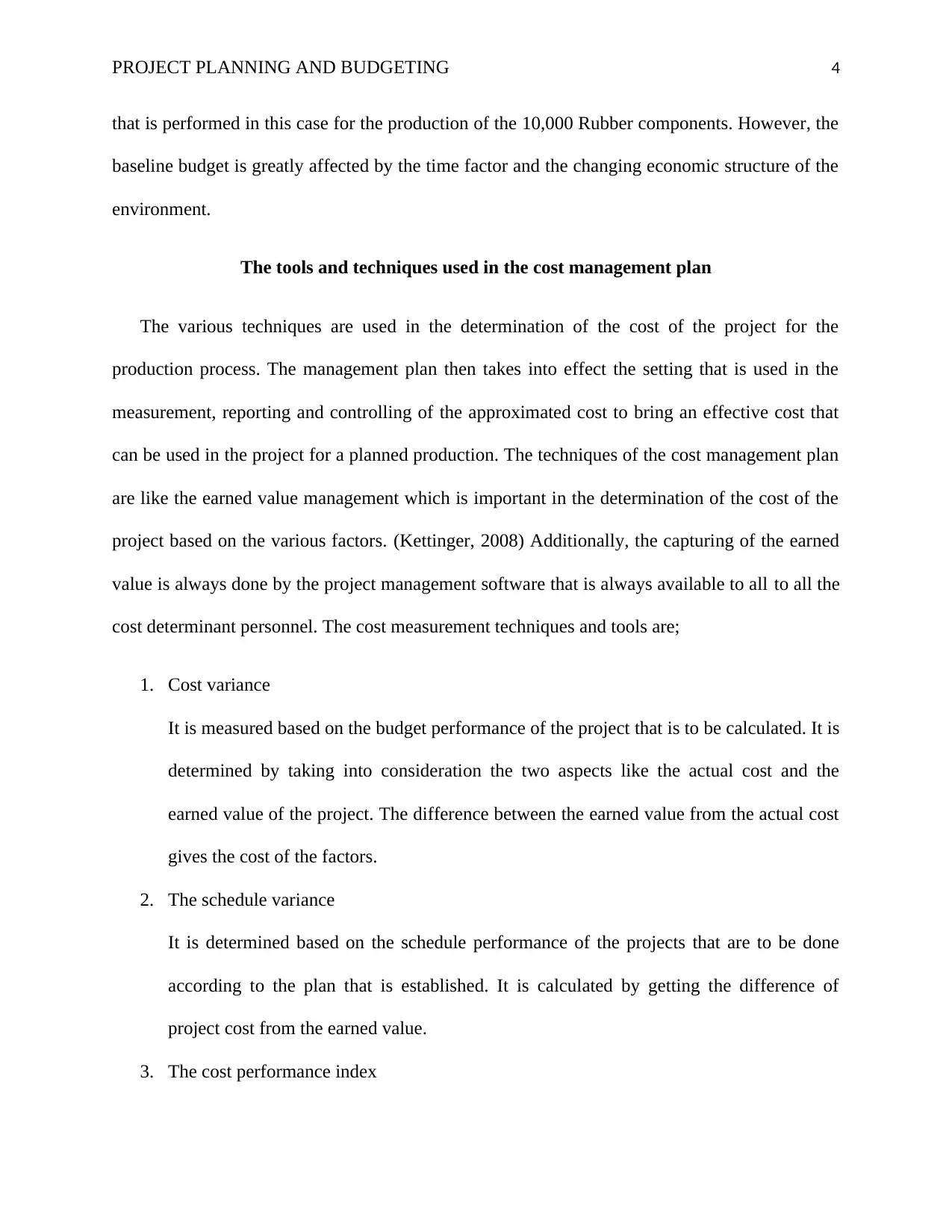
PROJECT PLANNING AND BUDGETING 4
that is performed in this case for the production of the 10,000 Rubber components. However, the
baseline budget is greatly affected by the time factor and the changing economic structure of the
environment.
The tools and techniques used in the cost management plan
The various techniques are used in the determination of the cost of the project for the
production process. The management plan then takes into effect the setting that is used in the
measurement, reporting and controlling of the approximated cost to bring an effective cost that
can be used in the project for a planned production. The techniques of the cost management plan
are like the earned value management which is important in the determination of the cost of the
project based on the various factors. (Kettinger, 2008) Additionally, the capturing of the earned
value is always done by the project management software that is always available to all to all the
cost determinant personnel. The cost measurement techniques and tools are;
1. Cost variance
It is measured based on the budget performance of the project that is to be calculated. It is
determined by taking into consideration the two aspects like the actual cost and the
earned value of the project. The difference between the earned value from the actual cost
gives the cost of the factors.
2. The schedule variance
It is determined based on the schedule performance of the projects that are to be done
according to the plan that is established. It is calculated by getting the difference of
project cost from the earned value.
3. The cost performance index
that is performed in this case for the production of the 10,000 Rubber components. However, the
baseline budget is greatly affected by the time factor and the changing economic structure of the
environment.
The tools and techniques used in the cost management plan
The various techniques are used in the determination of the cost of the project for the
production process. The management plan then takes into effect the setting that is used in the
measurement, reporting and controlling of the approximated cost to bring an effective cost that
can be used in the project for a planned production. The techniques of the cost management plan
are like the earned value management which is important in the determination of the cost of the
project based on the various factors. (Kettinger, 2008) Additionally, the capturing of the earned
value is always done by the project management software that is always available to all to all the
cost determinant personnel. The cost measurement techniques and tools are;
1. Cost variance
It is measured based on the budget performance of the project that is to be calculated. It is
determined by taking into consideration the two aspects like the actual cost and the
earned value of the project. The difference between the earned value from the actual cost
gives the cost of the factors.
2. The schedule variance
It is determined based on the schedule performance of the projects that are to be done
according to the plan that is established. It is calculated by getting the difference of
project cost from the earned value.
3. The cost performance index
Paraphrase This Document
Need a fresh take? Get an instant paraphrase of this document with our AI Paraphraser
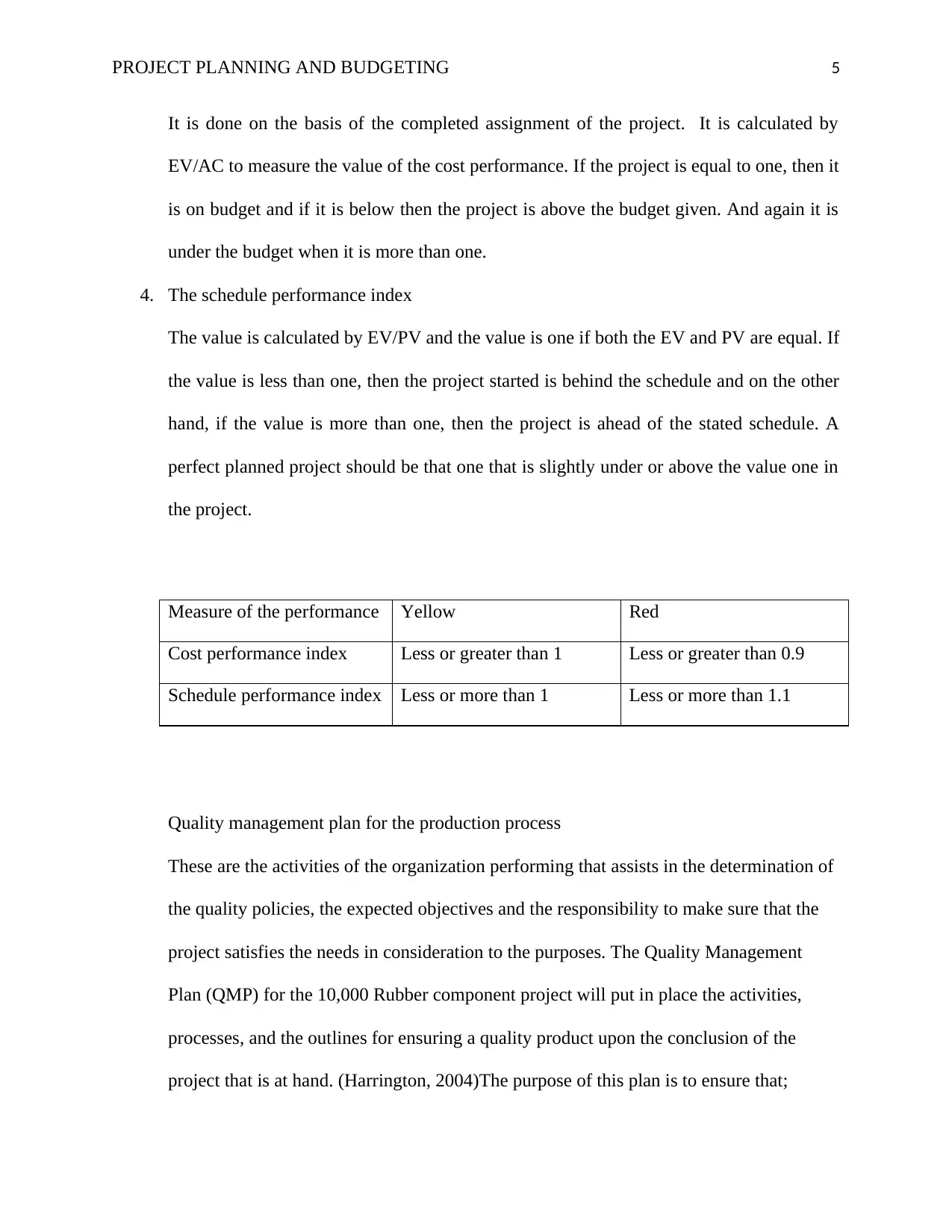
PROJECT PLANNING AND BUDGETING 5
It is done on the basis of the completed assignment of the project. It is calculated by
EV/AC to measure the value of the cost performance. If the project is equal to one, then it
is on budget and if it is below then the project is above the budget given. And again it is
under the budget when it is more than one.
4. The schedule performance index
The value is calculated by EV/PV and the value is one if both the EV and PV are equal. If
the value is less than one, then the project started is behind the schedule and on the other
hand, if the value is more than one, then the project is ahead of the stated schedule. A
perfect planned project should be that one that is slightly under or above the value one in
the project.
Measure of the performance Yellow Red
Cost performance index Less or greater than 1 Less or greater than 0.9
Schedule performance index Less or more than 1 Less or more than 1.1
Quality management plan for the production process
These are the activities of the organization performing that assists in the determination of
the quality policies, the expected objectives and the responsibility to make sure that the
project satisfies the needs in consideration to the purposes. The Quality Management
Plan (QMP) for the 10,000 Rubber component project will put in place the activities,
processes, and the outlines for ensuring a quality product upon the conclusion of the
project that is at hand. (Harrington, 2004)The purpose of this plan is to ensure that;
It is done on the basis of the completed assignment of the project. It is calculated by
EV/AC to measure the value of the cost performance. If the project is equal to one, then it
is on budget and if it is below then the project is above the budget given. And again it is
under the budget when it is more than one.
4. The schedule performance index
The value is calculated by EV/PV and the value is one if both the EV and PV are equal. If
the value is less than one, then the project started is behind the schedule and on the other
hand, if the value is more than one, then the project is ahead of the stated schedule. A
perfect planned project should be that one that is slightly under or above the value one in
the project.
Measure of the performance Yellow Red
Cost performance index Less or greater than 1 Less or greater than 0.9
Schedule performance index Less or more than 1 Less or more than 1.1
Quality management plan for the production process
These are the activities of the organization performing that assists in the determination of
the quality policies, the expected objectives and the responsibility to make sure that the
project satisfies the needs in consideration to the purposes. The Quality Management
Plan (QMP) for the 10,000 Rubber component project will put in place the activities,
processes, and the outlines for ensuring a quality product upon the conclusion of the
project that is at hand. (Harrington, 2004)The purpose of this plan is to ensure that;
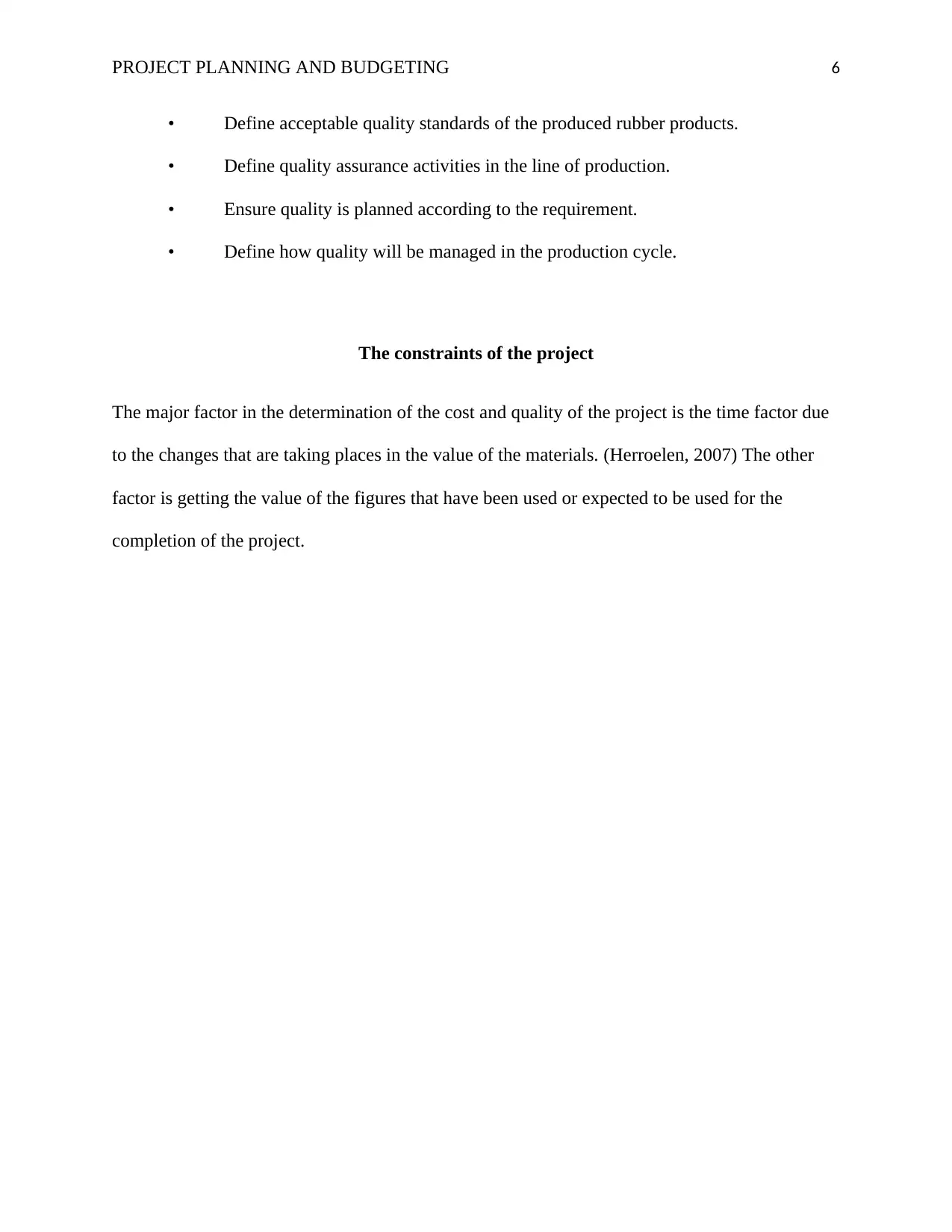
PROJECT PLANNING AND BUDGETING 6
• Define acceptable quality standards of the produced rubber products.
• Define quality assurance activities in the line of production.
• Ensure quality is planned according to the requirement.
• Define how quality will be managed in the production cycle.
The constraints of the project
The major factor in the determination of the cost and quality of the project is the time factor due
to the changes that are taking places in the value of the materials. (Herroelen, 2007) The other
factor is getting the value of the figures that have been used or expected to be used for the
completion of the project.
• Define acceptable quality standards of the produced rubber products.
• Define quality assurance activities in the line of production.
• Ensure quality is planned according to the requirement.
• Define how quality will be managed in the production cycle.
The constraints of the project
The major factor in the determination of the cost and quality of the project is the time factor due
to the changes that are taking places in the value of the materials. (Herroelen, 2007) The other
factor is getting the value of the figures that have been used or expected to be used for the
completion of the project.
⊘ This is a preview!⊘
Do you want full access?
Subscribe today to unlock all pages.

Trusted by 1+ million students worldwide
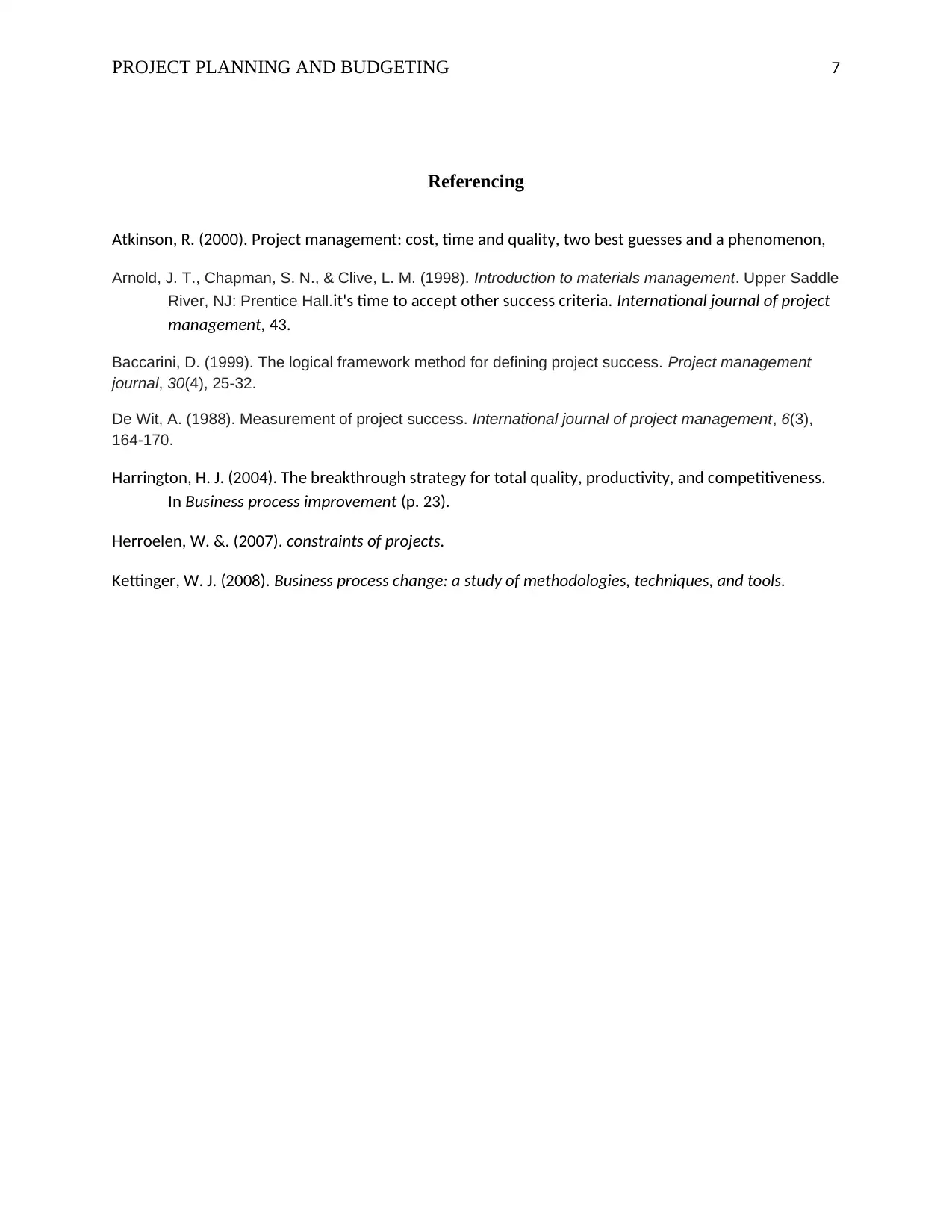
PROJECT PLANNING AND BUDGETING 7
Referencing
Atkinson, R. (2000). Project management: cost, time and quality, two best guesses and a phenomenon,
Arnold, J. T., Chapman, S. N., & Clive, L. M. (1998). Introduction to materials management. Upper Saddle
River, NJ: Prentice Hall.it's time to accept other success criteria. International journal of project
management, 43.
Baccarini, D. (1999). The logical framework method for defining project success. Project management
journal, 30(4), 25-32.
De Wit, A. (1988). Measurement of project success. International journal of project management, 6(3),
164-170.
Harrington, H. J. (2004). The breakthrough strategy for total quality, productivity, and competitiveness.
In Business process improvement (p. 23).
Herroelen, W. &. (2007). constraints of projects.
Kettinger, W. J. (2008). Business process change: a study of methodologies, techniques, and tools.
Referencing
Atkinson, R. (2000). Project management: cost, time and quality, two best guesses and a phenomenon,
Arnold, J. T., Chapman, S. N., & Clive, L. M. (1998). Introduction to materials management. Upper Saddle
River, NJ: Prentice Hall.it's time to accept other success criteria. International journal of project
management, 43.
Baccarini, D. (1999). The logical framework method for defining project success. Project management
journal, 30(4), 25-32.
De Wit, A. (1988). Measurement of project success. International journal of project management, 6(3),
164-170.
Harrington, H. J. (2004). The breakthrough strategy for total quality, productivity, and competitiveness.
In Business process improvement (p. 23).
Herroelen, W. &. (2007). constraints of projects.
Kettinger, W. J. (2008). Business process change: a study of methodologies, techniques, and tools.
1 out of 7
Related Documents
Your All-in-One AI-Powered Toolkit for Academic Success.
+13062052269
info@desklib.com
Available 24*7 on WhatsApp / Email
![[object Object]](/_next/static/media/star-bottom.7253800d.svg)
Unlock your academic potential
Copyright © 2020–2025 A2Z Services. All Rights Reserved. Developed and managed by ZUCOL.





